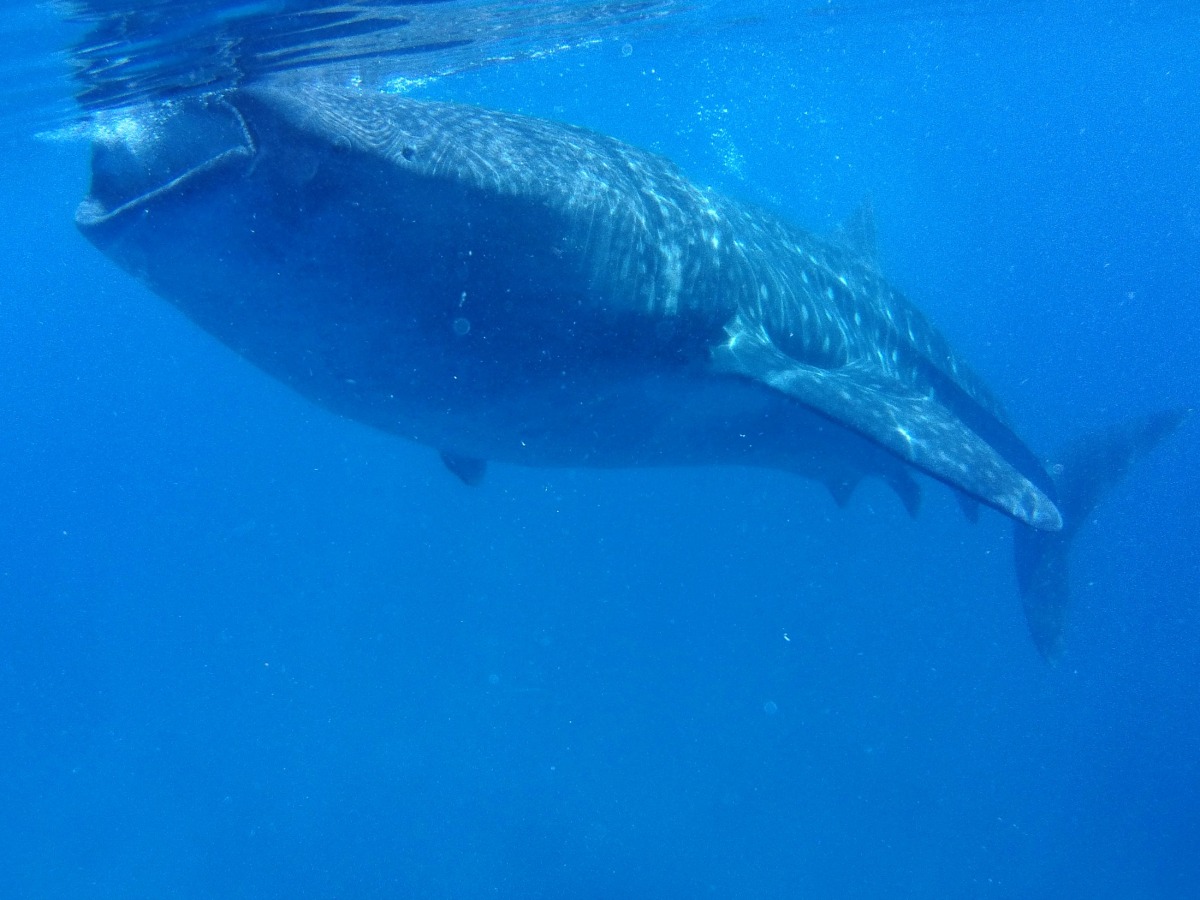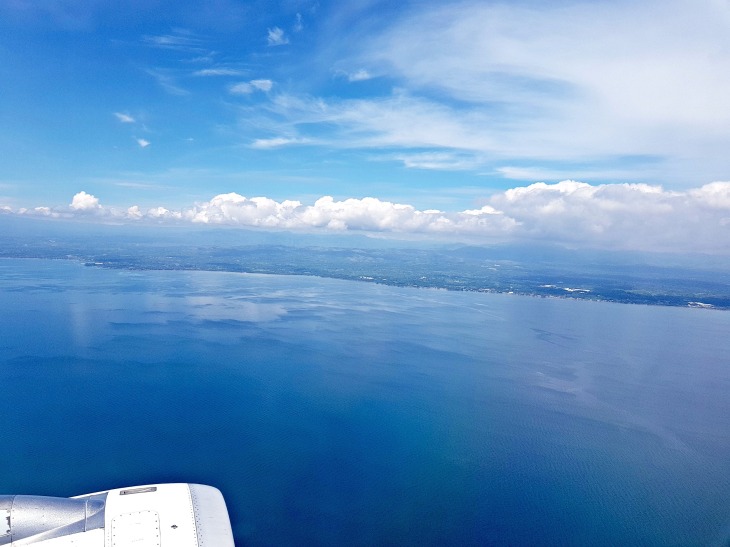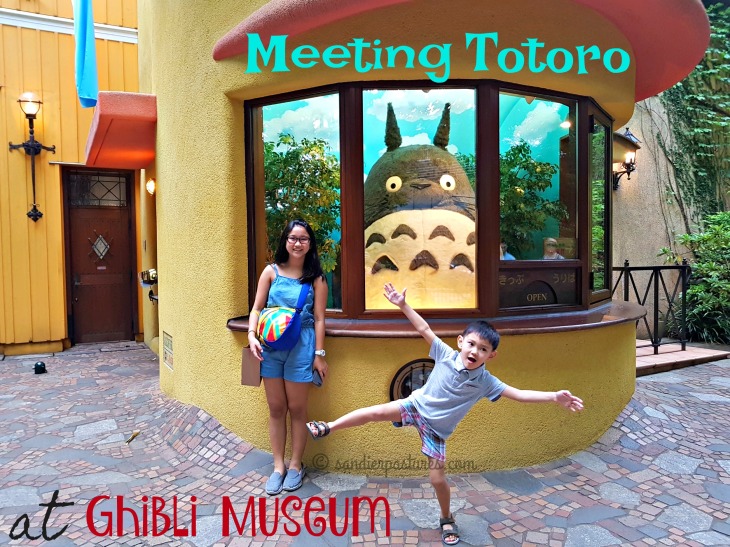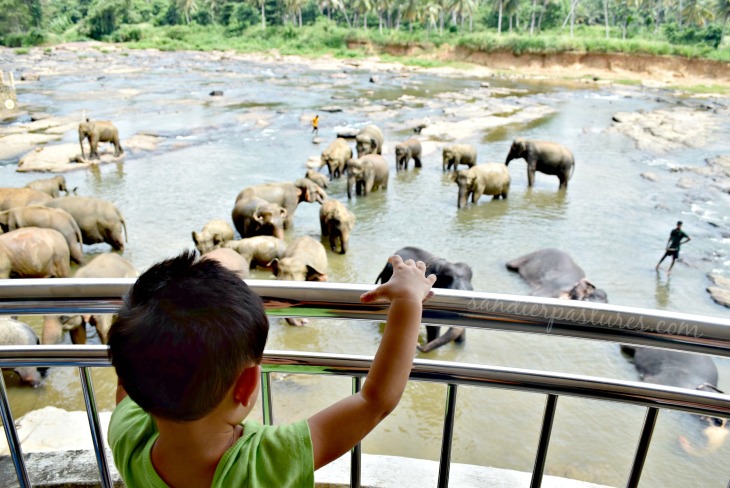This year, I took the kids again to the Philippines so they can spend the rest of their summer vacation (2 months!) after our 10 days vacation in Japan. We started to let them stay with my parents starting from last year because they’re better off there than being cooped up indoors in Dubai during the hottest time of the year.
My home town is an hour and a half airplane ride south of the capital Manila. Like I always, do, the kids always look forward to see the beautiful sight outside as the plane approaches Mindanao island.
I was to stay for only ten days before I needed to go back to Dubai so I wanted to take the kids for a small adventure: we go to Cebu island by sea transportation and see the whale sharks in Oslob!
WHERE IS OSLOB, CEBU?
The town of Oslob is located 120 kilometers south of Cebu City, in Cebu island, central Philippines. It is said that the residents of this coastal town started seeing whale sharks around 2012.
I have a long time friend who lives in Cebu so it was a perfect way to meet her again and for our kids to finally meet. This is my friend, through time and distance and weight fluctuations, we never lost touch and have been friends since we were 13!
HOW TO GET THERE
Oslob can be reached via domestic flights to Cebu or Dumaguete (from Manila) and then from Cebu City, which was our base, Oslob is at least three hours by car.
TIP: Leave Cebu City as early as possible to avoid the rush of tourists at Oslob. Aim to leave at 4am so you can reach just before 8am.
We left past 5 am and reached Oslob before 9 am and it was already full of tourists and the moment we finished everything from payment to the brief seminar about the do’s and don’ts of swimming with the whale sharks (DON’T GET TOO NEAR, MAINTAIN AT LEAST 4 FEET DISTANCE FROM THE WHALE SHARKS + NO SUNSCREEN LOTIONS), the sun was already high up and getting hot.
From the internet: Dumaguete/Sibulan port is closer to Oslob than Cebu City. It only takes a 30 minute boat ride from Sibulan port and then a Ceres bus ride or motorcycle ride to get to the whale shark watching area in Tan-awan town in Oslob.
TRAVELLING BY SEA

The kids and I got to Cebu City from Cagayan de Oro by sea transport – with a passenger ship leaving at 11 am and arriving Cebu City at nearly 8pm. The Philippines is an archipelago of more than 7,000 islands so commercial ships are still a popular mode of transportation when crossing one island to another. I used to travel this way in the 90s, since there no budget airline that existed that time and airplane fares were really expensive.
Usually, trips from Cagayan de Oro to Cebu leave at night at 8pm and arrive in Cebu at just before sunrise. But I wanted the kids to see the sea and the islands we pass by as the ship cruises through so I picked a day trip.
This was on the deck of the ship, many people were outside just soaking in the warm sun and inhaling the lovely sea breeze.
More than the kids, I had so much fun on this boat ride because it brought back so many wonderful memories – like the time I went to Manila (it take 30 hours!) to take the scholarship examination for Japan. I remember looking out into the sea, alone in the deck early in the morning with these thoughts running through my mind, “Lord, your will be done. If you think I need to be in Japan, then be it. I’ll accept it with all my heart…in fact, let me go there, Lord!” 🙂
SWIMMING WITH WHALE SHARKS
After a couple of days in Cebu, we set out to Oslob with my friend’s family. They have four kids and plus two of mine, their big car was full. I’m so happy her kids got along really well with my kids. Long car rides don’t matter much if you’re having fun.
After we paid the fees and finished listening to the briefing, we waited for more than one hour for our turn to get on the small, wooden boat. The boat left the shore and after just a few minutes, we were already in the deep end and finally near the whale sharks!
Life vests are provided and mandatory while on the boat but you should remove it so you can dive with ease. Presenting: the overly enthusiastic kids who immediately removed their life vests without batting an eyelash and got in the water!
Pristine had been waiting for this moment for a long time! These photos were taken by our diver/guide using the action camera we rented (PHP500 and they transfer the files to your mobile afterwards).
I am so proud of her!! I am so thankful the school she attended from Year 1 to 7 had a swimming pool because that’s where she learned how to swim and to be confident in the water.
Benjamin, though was in the water too, wasn’t able to swim underneath – I didn’t take off his arm floaters (there were no life vests small enough for him that was available). I felt he was too young to be submerged in the water long enough so the guide can take a photo of him. However, he was still able to see the whale sharks up close.
These pics were taken when they come up to feed.
Meanwhile, you can see that at this point, only the adults are left in the boat! LOL. Me, my friend Divina and her husband are all non-swimmers. It was nearly noon and getting really, really hot. I was so, so tempted to get in the water just to cool off!
I wasn’t able to bear the heat, I jumped in!! There was something wrong with the way I put on my life vest, it was trying to get into my head and I hated it but at least my body is cooler now.
Confession time. I am scared of the deep blue sea. Mostly, maybe because I don’t know how to tread when the water is too deep (shame). And next, I am scared of what lies beneath. I am cringing just by writing this post. Our diver/guide told me so many times that our limited time (30 minutes!) was running out and that I had to take off the life vest now so he can push me underwater and take a picture of me with the whale shark in the background. For, you know, BRAGGING RIGHTS.
Some pics of Pristine swimming around with my friend’s kids. These bunch earned some serious bragging rights at this young age.
After so much hard thinking about this very important life or death decision, I decided not to take off my life jacket because trust me, I know I’m going to sink faster than the Titanic to the bottom of the sea. The diver/guide who was with us assured me he will not allow me to drown and would save me, if ever but no, no, no!! My kids still need their mother so I was just there, floating and sighing, hearing my daughter shouting YOLO, mama! YOLO!! (YOLO = You Only Live Once)
Do I regret not removing my life jacket? Kind of. Don’t get me wrong, maybe 95% of me still say I did the right thing of choosing safe than sorry but 5% is whispering, what if.
The what if that I’m going to live with for the rest of my life.
That said, I am happy my kids are braver than me or rather, are able swimmers than me. Pristine had been wanting to do this since she was 8. And Benjamin, well, maybe next time when he is older.
The whale sharks are beautiful and peaceful creatures and is an awe to watch and our experience watching them up close is definitely unforgettable.
TIPS BEFORE YOU GO
1. Go early. Whale shark watching starts at 6 am to 12 noon only. Cut off is 1130 am. The earlier you are, the less crowd plus the water is clearer early in the morning.
2. Though the “whale watching fee” includes gear (snorkeling), it’s best to bring your own goggles.
3. Wear long sleeve rash guard/UV clothing as it gets really hot before you notice it. Sunburns are no fun! Also, sunscreen lotions are strictly NOT allowed so protect your skin.
4. The “whale watching” time is just 30-minutes so if you can, jump as soon as your boatmen signal or you will waste/miss the chance.
5. The charge for whale shark swimming is PHP1,000 ($23) for a half hour session. Fess can be paid in cash only before the tour at Barangay Tan-awan Beach, Oslob so prepare cash.
DO I RECOMMEND SWIMMING WITH WHALE SHARKS IN OSLOB?
Swimming with the whale sharks in Oslob was an incredible experience. You might have read somewhere though, that some environmentalist groups are against this activity due to injuries to the whale sharks by boat propellers but this is outdated info as the boats that were used were all trimarans with no motor/engine, only oars. Another controversial thing is the guides feed the sharks; the animals expect this now so it affects their usual routine and behavior. The feeding sessions make the whale sharks overly dependent on the handouts. But, the boom of this tourism activity is helping the local economy. The whale sharks contribute tremendously to Oslob’s income, helping to create much needed infrastructure, jobs, and opportunities for growth with neighboring municipalities. Nearly 300 staff work at the feeding site, under local government management, to safeguard the sea creatures.
It’s a difficult balance.
But, personally, I find that the government is working hard to protect these creatures as much as they can by strictly regulating the time when to feed and see the whales and conduct clear briefing on the do’s and don’ts. I’ll leave the decision to you whether you’d go for this or not.
I would say go but be a responsible tourist and follow the rules.


























































































































































